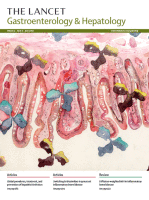Activity/Impact
Activity
Impact
2013
Activity
Generated HCV Medicines and Diagnostics Report for UNITAID
This scoping report focuses on issues, challenges and opportunities related to one of the most important HIV co-infections—Hepatitis C virus (HCV)—and represents UNITAID’s first effort to gather market intelligence on products for the diagnosis and treatment of HCV in individuals co-infected with HIV and HCV.
Deelder W, Eustance J, Pingali P, et al.
Activity
Showed HCV elimination with increased treatment and high SVR
Hepatitis C virus (HCV) infection is a leading cause of cirrhosis, hepatocellular carcinoma, and liver transplantation. A better understanding of HCV disease progression and the associated cost can help the medical community manage HCV and develop treatment strategies in light of the emergence of several potent anti-HCV therapies.
Razavi H, Elkhoury AC, Elbasha E, et al.
Activity
Recommended testing and treatment of HCV using oral therapies
Emerging data indicate that all-oral antiviral treatments for chronic hepatitis C virus (HCV) will become a reality in the near future. In replacing interferon-based therapies, all-oral regimens are expected to be more tolerable, more effective, shorter in duration and simpler to administer. Coinciding with new treatment options are novel methodologies for disease screening and staging, which create the possibility of more timely care and treatment.
Afdhal NH, Zeuzem S, Schooley RT, et al.
2014
Activity
Published the impact of HCV elimination in 15 countries
The number of hepatitis C virus (HCV) infections is projected to decline while those with advanced liver disease will increase. A modeling approach was used to forecast two treatment scenarios: (i) the impact of increased treatment efficacy while keeping the number of treated patients constant and (ii) increasing efficacy and treatment rate.
Wedemeyer H, Duberg AS, Buti M, et al.
Activity
Lowered global HCV prevalence from 185 million to 80 million
The treatment of chronic hepatitis C virus (HCV) infection has the potential to change significantly over the next few years as therapeutic regimens are rapidly evolving. However, the burden of chronic infection has not been quantified at the global level using the most recent data. Updated estimates of HCV prevalence, viremia and genotypes are critical for developing strategies to manage or eliminate HCV infection.
Gower E, Estes C, Blach S, et al.
Activity
Assessed the impact of HCV elimination in Egypt
Hepatitis C virus (HCV) infection is a major public health burden in Egypt [1], [2]. A number of studies have characterised HCV infection rate in Egypt [3], [1], [4], [5] but they have focused on quantifying the prevalence or total number of HCV infections. The future outlook of the disease burden is not known. This, however, is expected to increase as the infected population ages [6], [7].
Waked I, Doss W, El-Sayed MH, et al.
2015
Activity
Published the impact of HCV elimination in 31 countries
The hepatitis C virus (HCV) epidemic was forecasted through 2030 for 15 countries, and the relative impact of two scenarios was considered: (i) increased treatment efficacy while holding the treated population constant and (ii) increased treatment efficacy and increased annual treated population. Increasing levels of diagnosis and treatment, in combination with improved treatment efficacy, were critical for achieving substantial reductions in disease burden.
Gane E, Kershenobich D, Seguin-Devaux C, et al.
Activity
Assessed expanding MPP’s mandate into HCV
Impact
MPP expands mandate to include HCV in 2016.

Activity
Launched the Polaris Observatory, covering over 100 countries
The Polaris Observatory’s teams of epidemiologists work directly with stakeholders in over 100 countries/territories to assess the current – and future – disease burden of hepatitis, model economic impact, and develop strategies that can achieve country/territory-defined targets to eliminate it.
2016
Activity
Launched the annual list of countries on the path to elimination
All-oral direct-acting antiviral drugs (DAAs) for hepatitis C virus, which have response rates of 95% or more, represent a major clinical advance. However, the high list price of DAAs has led many governments to restrict their reimbursement. We reviewed the availability of, and national criteria for, interferon-free DAA reimbursement among countries in the European Union and European Economic Area, and Switzerland. Reimbursement documentation was reviewed between Nov 18, 2016, and Aug 1, 2017.
Alison D Marshall, Evan B Cunningham, et al.
Impact
All countries in the European Union remove restrictions for HCV treatment in 2018.
Activity
Showed the impact of national elimination with Taiwan MoH
Impact
Taiwan removes all restrictions and funds the national plan in 2019.
Activity
Updated global HCV prevalence to 71 million
The 69th World Health Assembly approved the Global Health Sector Strategy to eliminate hepatitis C virus (HCV) infection by 2030, which can become a reality with the recent launch of direct acting antiviral therapies. Reliable disease burden estimates are required for national strategies. This analysis estimates the global prevalence of viraemic HCV at the end of 2015, an update of-and expansion on-the 2014 analysis, which reported 80 million (95% CI 64-103) viraemic infections in 2013.
Blach S, Zeuzem S, Manns M, et al.
Impact
The World Health Organization adopts Polaris HCV and HBV data for its hepatitis reports and adopts 71 million as the global HCV prevalence.
2017
Activity
Published a study on the impact of HCV elimination in the EU
n the European Union (EU), treatment and cure of HCV with direct-acting antiviral therapies began in 2014. WHO targets are to achieve a 65% reduction in liver-related deaths, a 90% reduction of new viral hepatitis infections, and 90% of patients with viral hepatitis infections being diagnosed by 2030.
Razavi H, Robbins S, et al.
Activity
Updated global HCV prevalence to 71 million
Hepatitis B and C cause most cases of hepatitis in the United States and the world. The two diseases account for about a million deaths a year and 78 percent of world’s hepatocellular carcinoma and more than half of all fatal cirrhosis.
National Academies of Sciences, et al.
Impact
The pieces are set, waiting to see what is to come.
2018
Activity
Assessed the impact of HBV birth-dose vaccination for VIMC/Gavi
The Gavi Board has made a series of decisions that will help shape the Alliance’s approach for the period 2021-2025 during a two-day meeting in Geneva’s Global Health Campus. The Board will adopt the 2021-2025 strategic goals at its next meeting in June 2019.
The Gavi Board
Impact
The Gavi Board approves funding HBV birth-dose vaccination in 2019.
Activity
Updated global HBV prevalence to 292 million
The 69th World Health Assembly approved the Global Health Sector Strategy to eliminate viral hepatitis by 2030. Although no virological cure exists for hepatitis B virus (HBV) infection, existing therapies to control viral replication and prophylaxis to minimise mother-to-child transmission make elimination of HBV feasible.
Razavi-Shearer D, Gamkrelidze I, Nguyen MH, et al.
Impact
The pieces are set, waiting to see what is to come.
2019
Activity
Showed that HBV test and treat is more effective than SoC
More than 250 million people worldwide are chronically infected with the hepatitis B virus (HBV). In this Comment, members of the International Coalition to Eliminate HBV appraise the current policy environment and the need for appropriate cure research and preparedness to complement the WHO global elimination strategy, the HBV vaccine and the well- tolerated but poorly accessed therapy.
Lazarus JV, Block T, et al.
Activity
Launched UHEP catalytic financing of hepatitis elimination
CDA Foundation has developed a scalable, sustainable catalytic funding mechanism that allows countries/territories to start their hepatitis elimination programs without a large upfront investment.
Impact
The pieces are set, waiting to see what is to come.
















